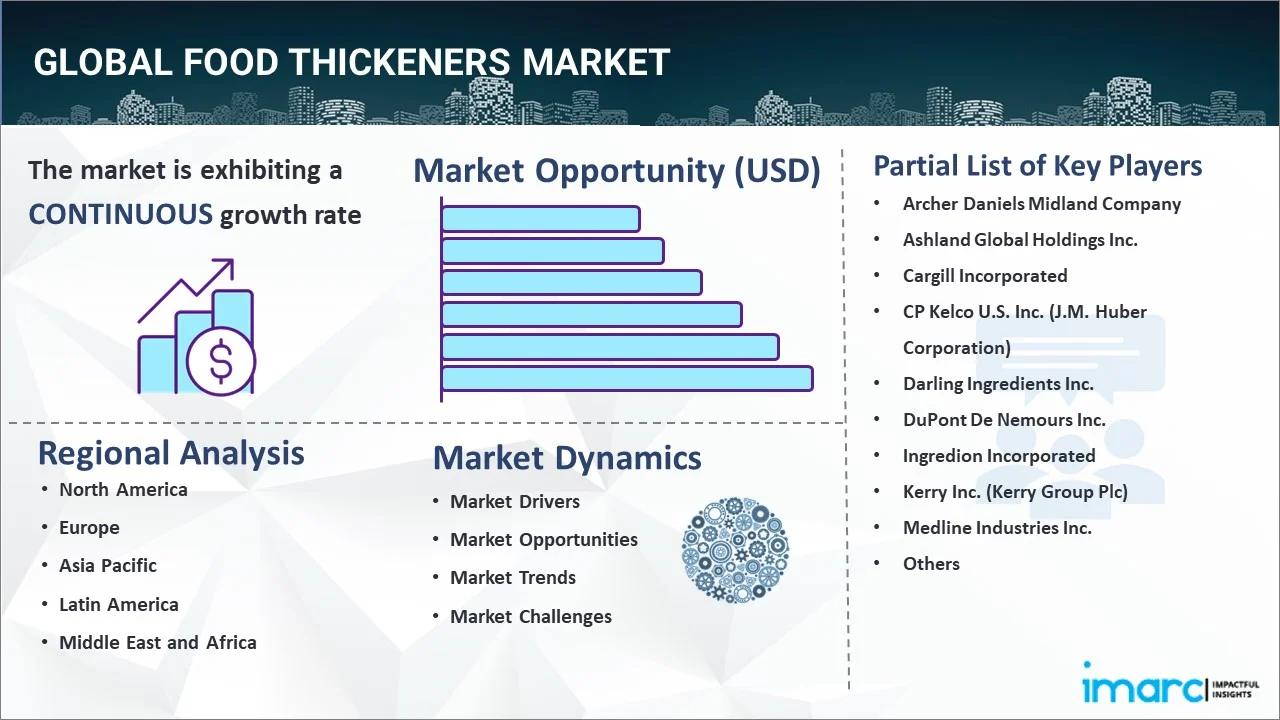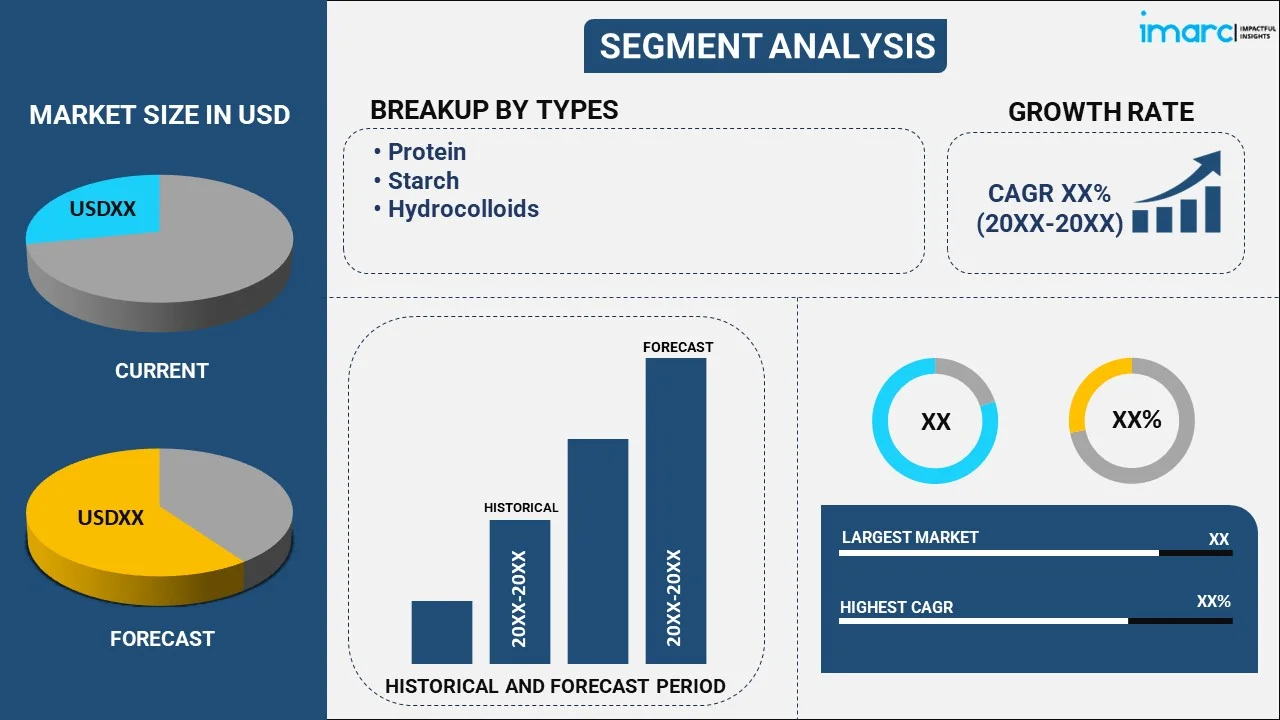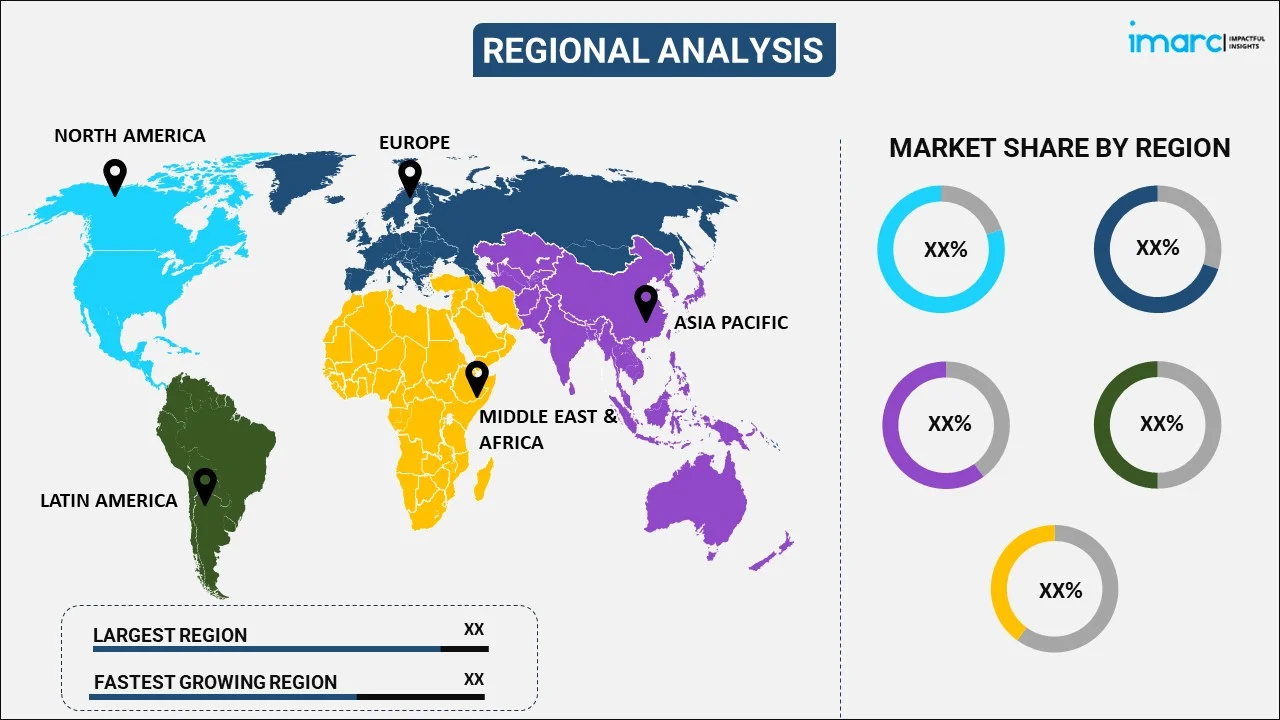
Food Thickeners Market Report by Type (Protein, Starch, Hydrocolloids), Source (Plant, Animal, Microbial), Application (Bakery, Confectionery, Sauces and Dips, Beverages, Convenience and Processed Food, and Others), and Region 2025-2033
Food Thickeners Market Size:
The global food thickeners market size reached USD 15.8 Billion in 2024. Looking forward, IMARC Group expects the market to reach USD 23.2 Billion by 2033, exhibiting a growth rate (CAGR) of 4.4% during 2025-2033. The market is thriving due to escalating demand for convenience foods, growing health-conscious consumer trends towards functional and clean label products, growth in plant-based diets, advancements in food processing technologies, and stringent regulatory standards ensuring safety and quality.
|
Report Attribute
|
Key Statistics
|
|---|---|
|
Base Year
|
2024
|
|
Forecast Years
|
2025-2033
|
|
Historical Years
|
2019-2024
|
|
Market Size in 2024
|
USD 15.8 Billion |
|
Market Forecast in 2033
|
USD 23.2 Billion |
| Market Growth Rate 2025-2033 | 4.4% |
Food Thickeners Market Analysis:
- Major Market Drivers: According to the food thickener market overview, the main drivers that boost market expansion include expanding demand for convenience foods across the globe, rising health and nutritional trends, and emerging need for functional food items.
- Key Market Trends: In accordance with the product market forecast and statistics, the increasing shift toward clean-label ingredients as consumers demand greater transparency, as well as rapid technological advancements in food processing and microencapsulation technologies that provide more effective and efficient thickener use, are driving the market growth.
- Geographical Trends: North America currently leads the market. The region benefits from modern food processing companies and strong consumer awareness of food safety and quality. Other regions are expanding as a result of increased urbanization, rising disposable incomes, and westernization of cuisine.
- Competitive Landscape: Some of the major market players in the food thickeners industry include Archer Daniels Midland Company, Ashland Global Holdings Inc., Cargill Incorporated, CP Kelco U.S. Inc. (J.M. Huber Corporation), Darling Ingredients Inc., DuPont De Nemours Inc., Ingredion Incorporated, Kerry Inc. (Kerry Group Plc), Medline Industries Inc. and Tate & Lyle Plc., among many others.
- Challenges and Opportunities: The market faces several hurdles, including changing raw material costs and regulatory constraints that vary by country. However, growing consumer interest in plant-based and ecological products creates substantial opportunity.

Food Thickeners Market Trends:
Rising Demand for Convenience Foods
The increasing consumer preference for convenience foods like ready-to-eat (RTE) meals, instant foods, and processed foods is boosting product demand. These convenience food items need food thickeners to enhance texture, stability, and shelf life. Also, the busy lifestyles of consumers are leading to a higher demand for quick and easy meal options. Increased urbanization has resulted in longer commutes for many individuals, which consume large amounts of their day and contribute to a hurried lifestyle. According to Our World in Data, Tokyo (Japan) had the world's highest capital city population in 2018, with over 37 million inhabitants. This was followed by Delhi (India) at over 28 million, Mexico City (Mexico) at 21 million, and Cairo (Egypt) at 20 million, all of which contributed to a sense of overpopulation and rivalry for resources, hastening the pace of life even more. Food thickeners like xanthan gum, guar gum, and starch-based thickeners are known to improve the mouthfeel and viscosity of foods, which is making them more appealing to busy consumers.
Rising Health and Dietary Trends Influencing Product Formulations
The market price for food thickeners is growing as consumers are increasingly becoming health conscious. They are seeking healthier food options that are low in fat and calories but high in nutritional value. This shift has led food manufacturers to reformulate their products to meet these demands, often incorporating natural and plant-based thickeners such as agar-agar, pectin, and alginate. According to the Global Food Institute (GFI), plant-based foods were purchased by six out of ten U.S. families in 2022. Additionally, the prevalence of gluten intolerance and celiac disease is increasing, which is driving the demand for gluten-free thickening agents such as cornstarch and tapioca starch. The presence of celiac disease is 0.7% based on the biopsy results and 1.4% as per blood testing worldwide. Also, in India, the prevalence of celiac disease has jumped by four times since the 1960s, and now, 80 lakh people are affected, according to researchers at the International Symposium on Wheat-Related Disorders (ISWD). To counter that, the gluten-free product industry is rapidly growing and is estimated to reach USD 39.0 Billion by 2032, with 7.1% annual growth pace, thereby positively impacting the product market revenue.
Increasing Popularity of Functional Foods
The rising consumer interest in functional foods is a significant driver of the product market growth. Functional foods are packed with nutrients and certain ingredients that are known to provide health benefits that are beyond basic nutrition. Their market is growing at a rapid pace of 5.7% yearly. It is also expected to touch USD 368.9 Billion by 2032. To enhance mouthfeel and ensure that added vitamins, minerals, and probiotics are incorporated into many products, food thickeners are also used in yogurt, smoothies, and fortified beverages. Nearly two-thirds of U.S. adults say they are now more focused on their own health than they were a year ago, according to HealthFocus. Among those aged 65-plus, seven out of 10 are more health conscious. And two-thirds of adults in the United States look for food and drinks with vitamins and minerals. A Kerry survey of consumers in 16 countries found that four in 10 people (42%) bought more functional foods in 2021 than in 2020. This data is crucial for research on food thickener market outlook as it highlights how important they are in functional food items because they improve the food’s consistency and texture.
Food Thickeners Market Segmentation:
IMARC Group provides an analysis of the key trends in each segment of the market, along with forecasts at the global, regional, and country levels for 2025-2033. Our report has categorized the market based on type, source, and application.
Breakup by Type:

- Protein
- Starch
- Hydrocolloids
Hydrocolloids accounts for the majority of the market share
The report has provided a detailed breakup and analysis of the market based on the type. This includes protein, starch, and hydrocolloids. According to the report, hydrocolloids represented the largest segment.
As per the food thickener market segmentation and trends, the hydrocolloids segment holds the largest share due to its diverse applications across multiple food industries. Hydrocolloids, such as xanthan gum, guar gum, and alginate, are prized for their ability to modify the viscosity and texture of food products effectively while maintaining stability and aesthetics. Moreover, they are utilized in various products such as bakery goods and confectioneries to meat and dairy alternatives. Additionally, the versatility of hydrocolloids in improving the sensory attributes of gluten-free and low-fat foods while catering to the rising consumer demand for healthier and dietary-specific options is positively influencing the product market demand.
Breakup by Source:
- Plant
- Animal
- Microbial
Plant holds the largest share of the industry
A detailed breakup and analysis of the market based on the source have also been provided in the report. This includes plant, animal, and microbial. According to the report, plant accounted for the largest market share.
Plant-based food thickeners emerged as the largest segment. They include starches derived from corn, tapioca, and potato, along with gums like guar, xanthan, and pectin. Plant-based thickeners are crucial for manufacturers to meet the soaring consumer demand for vegan, gluten-free, and clean-label products. Moreover, the versatility and functionality of plant-based thickeners, which offer excellent thickening, stabilizing, and gelling properties without compromising on taste or appearance, are positively influencing the product's market share and value. Additionally, the growing environmental awareness among consumers, boosting the preference for ingredients that are derived from renewable sources, is fostering the market growth.
Breakup by Application:
- Bakery
- Confectionery
- Sauces and Dips
- Beverages
- Convenience and Processed Food
- Others
Bakery represents the leading market segment
The report has provided a detailed breakup and analysis of the market based on the application. This includes bakery, confectionery, sauces and dips, beverages, convenience and processed food, and others. According to the report, bakery represented the largest segment.
The bakery segment constituted the largest market share. This dominance is driven by the critical role thickeners play in achieving desired textures and consistency in bakery products, such as breads, pastries, cakes, and biscuits. Thickeners like xanthan gum, guar gum, and various starches are essential for providing structure, moisture retention, and stability. Moreover, they help improve the shelf life and enhance the mouthfeel of the final products, which is vital for consumer satisfaction. Along with this, the introduction of healthier and more diverse products, such as gluten-free and low-calorie options, boosting the demand for versatile and effective food thickeners is propelling the market growth.
Breakup by Region:

- North America
- United States
- Canada
- Asia-Pacific
- China
- Japan
- India
- South Korea
- Australia
- Indonesia
- Others
- Europe
- Germany
- France
- United Kingdom
- Italy
- Spain
- Russia
- Others
- Latin America
- Brazil
- Mexico
- Others
- Middle East and Africa
North America leads the market, accounting for the largest food thickeners market share
The report has also provided a comprehensive analysis of all the major regional markets, which include North America (the United States and Canada); Asia Pacific (China, Japan, India, South Korea, Australia, Indonesia, and others); Europe (Germany, France, the United Kingdom, Italy, Spain, Russia, and others); Latin America (Brazil, Mexico, and others); and the Middle East and Africa. According to the report, North America represents the largest regional market for food thickeners.
According to the product market research and analysis, North America holds the largest share due to its robust food and beverage (F&B) industry, a high degree of consumer awareness, and stringent food safety regulations. Moreover, the increasing consumer demand for processed and convenience foods, which extensively use thickeners to enhance texture and stability, is bolstering the market growth. North America is also a leader in the health and wellness trend, driving significant demand for natural and clean-label thickening agents that align with consumers' dietary preferences, such as gluten-free and vegan. Besides this, the presence of major food thickeners manufacturers and ongoing research and development (R&D) activities in food technology that ensure continuous innovation and supply of high-quality thickeners, is positively impacting the market growth.
Competitive Landscape:
The report has also provided a comprehensive analysis of the competitive landscape in the global food thickeners market. Competitive analysis such as market structure, market share by key players, player positioning, top winning strategies, competitive dashboard, and company evaluation quadrant has been covered in the report. Also, detailed profiles of all major companies have been provided. Some of the companies covered include:
- Archer Daniels Midland Company
- Ashland Global Holdings Inc.
- Cargill Incorporated
- CP Kelco U.S. Inc. (J.M. Huber Corporation)
- Darling Ingredients Inc.
- DuPont De Nemours Inc.
- Ingredion Incorporated
- Kerry Inc. (Kerry Group Plc)
- Medline Industries Inc.
- Tate & Lyle Plc
Kindly note that this only represents a partial list of companies, and the complete list has been provided in the report.
The top companies in the product market are engaging in research and development (R&D) to innovate and enhance their product offerings while meeting evolving consumer demands for healthier, sustainable, and versatile ingredients. They are expanding their product portfolios to include a wider range of natural and organic thickeners that cater to the clean-label trend. Moreover, the key players are forming strategic mergers and acquisitions to broaden their technological capabilities and market reach. Along with this, they are investing in facilities in emerging markets to tap into local resources and reduce production costs, thereby enhancing their competitive edge. Additionally, major firms are engaging in partnerships with food manufacturers to ensure tailored solutions that meet specific application needs, such as bakery products and dairy alternatives, thereby expanding the product market opportunities and recent developments. Besides this, they are improving their sourcing practices and production processes to minimize environmental impact to resonate with the global shift towards sustainable development in the food industry.
Food Thickeners Market News:
- In September 2022, Cargill established its maize wet mill in Surabaya to meet Asia's growing need for starches, sweeteners, and feeds. It is a USD 100 Million facility that is expected to stimulate the expansion of the beverage and food industry across Asia, as well as offer up to 4,000 new jobs and employment opportunities.
- In February 2024, Ingredion introduced its new HOMECRAFT pulse flours and starches. This category consists of a line of clean-label thickeners that are derived from lentils, chickpeas and yellow peas. These flours have thickening and texturizing qualities that meet the customer demand for natural and sustainable ingredients.
- In February 2024, Tate & Lyle announced PROMITA F200, which is a plant-based thickener suited for dairy replacements. This new product is designed to improve the texture and mouthfeel of plant-based yoghurts, beverages, and desserts.
Food Thickeners Market Report Scope:
| Report Features | Details |
|---|---|
| Base Year of the Analysis | 2024 |
| Historical Period | 2019-2024 |
| Forecast Period | 2025-2033 |
| Units | Billion USD |
| Scope of the Report | Exploration of Historical Trends and Market Outlook, Industry Catalysts and Challenges, Segment-Wise Historical and Future Market Assessment:
|
| Types Covered | Protein, Starch, Hydrocolloids |
| Sources Covered | Plant, Animal, Microbial |
| Applications Covered | Bakery, Confectionery, Sauces and Dips, Beverages, Convenience and Processed Food, Others |
| Regions Covered | Asia Pacific, Europe, North America, Latin America, Middle East and Africa |
| Countries Covered | United States, Canada, Germany, France, United Kingdom, Italy, Spain, Russia, China, Japan, India, South Korea, Australia, Indonesia, Brazil, Mexico |
| Companies Covered | Archer Daniels Midland Company, Ashland Global Holdings Inc., Cargill Incorporated, CP Kelco U.S. Inc. (J.M. Huber Corporation), Darling Ingredients Inc., DuPont De Nemours Inc., Ingredion Incorporated, Kerry Inc. (Kerry Group Plc), Medline Industries Inc., Tate & Lyle Plc., etc. |
| Customization Scope | 10% Free Customization |
| Post-Sale Analyst Support | 10-12 Weeks |
| Delivery Format | PDF and Excel through Email (We can also provide the editable version of the report in PPT/Word format on special request) |
Key Benefits for Stakeholders:
- IMARC’s industry report offers a comprehensive quantitative analysis of various market segments, historical and current market trends, market forecasts, and dynamics of the food thickeners market from 2019-2033.
- The research report provides the latest information on the market drivers, challenges, and opportunities in the global food thickeners market.
- The study maps the leading, as well as the fastest-growing, regional markets. It further enables stakeholders to identify the key country-level markets within each region.
- Porter's five forces analysis assists stakeholders in assessing the impact of new entrants, competitive rivalry, supplier power, buyer power, and the threat of substitution. It helps stakeholders to analyze the level of competition within the food thickeners industry and its attractiveness.
- The competitive landscape allows stakeholders to understand their competitive environment and provides insight into the current positions of key players in the market.
Key Questions Answered in This Report
The food thickeners market was valued at USD 15.8 Billion in 2024.
The food thickeners market is projected to exhibit a CAGR of 4.4% during 2025-2033, reaching a value of USD 23.2 Billion by 2033.
The food thickeners market is driven by the growing need for enhanced texture, consistency, and stability in various food and beverage products. Rising consumer preference for natural and plant-based ingredients, along with the development of innovative thickeners for processed and specialty foods, supports market growth across diverse applications.
North America currently dominates the food thickeners market owing to its well-established food processing industry, high demand for convenience and processed foods, and widespread use of innovative food technologies. The region’s focus on clean-label, gluten-free, and plant-based products further drives the development and adoption of diverse thickening agents.
Some of the major players in the food thickeners market include Archer Daniels Midland Company, Ashland Global Holdings Inc., Cargill Incorporated, CP Kelco U.S. Inc. (J.M. Huber Corporation), Darling Ingredients Inc., DuPont De Nemours Inc., Ingredion Incorporated, Kerry Inc. (Kerry Group Plc), Medline Industries Inc., Tate & Lyle Plc., etc.
Need more help?
- Speak to our experienced analysts for insights on the current market scenarios.
- Include additional segments and countries to customize the report as per your requirement.
- Gain an unparalleled competitive advantage in your domain by understanding how to utilize the report and positively impacting your operations and revenue.
- For further assistance, please connect with our analysts.
 Request Customization
Request Customization
 Speak to an Analyst
Speak to an Analyst
 Request Brochure
Request Brochure
 Inquire Before Buying
Inquire Before Buying




.webp)




.webp)












